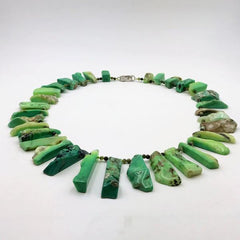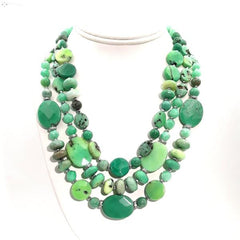Variscite
Variscite Jewelry

For 6000 years ago, mankind has been fashioning jewelry from Variscite. Pliny The Elder recorded mention of a stone called Callais (callenite) and when a set of Neolithic beads were found in France, the beads were named after that stone. The beads were thought to be turquoise, but that was quickly disproven. Some scholars thought this proved a Neolithic trade route between Europe & Asia, but Variscite was subsequently found in Italy. Still this is proof of a wide ranging Pan-European gem trade as early as 4000 BC
Check out our Variscite Necklaces
Variscite is often used for carving and ornaments thanks to its intense green color. Many times Variscite will be used in jewelry, particularly silver jewelry, in place of turquoise. While Variscite is actually rarer than turquoise, it is not widely known or collected, so Variscite tends to be an economical replacement for turquoise.
Among various names, Variscite has been called Utahcite, Lucinite, and Variquoise. One type of Variscite from Nevada is called Amatrice or Amatrix for American Matrix. When banded, Variscite has been called Sabalite and Tranite.
Identifying Variscite

Sometimes it is difficult for an expert to distinguish between Turquoise & Variscite. The key identifiers are the greener shades normally found in Variscite, a lower refractive index than turquoise, and it is noticeably softer than turquoise.
There are synthetic versions of Variscite that have been made in the laboratory. Look for pink or red splotches on the stone to identify the synthetic variety.
Variscite is very susceptible to scratching. Clean with a soft brush, warm water and a mild detergent. It is best to have Variscite set in a protective setting for jewelry purposes due to its low hardness.









